The STX Inflatable Windsurf 280 is the board that initially introduced me to the STX brand. I first discovered the board on display in a shop and it’s simplicity, versatility and price point immediately appealed to me. I had sailed a few WindSUPs, but this board seemed like it had more to offer. On paper it seemed to be a “Jack of all trades” which could be used by beginner and intermediate windsurfers, but with straps and a release edge so that planning was also possible. I was immediately interested in the concept and contacted STX to try and get my hands on a test board.
The Board
The Board is 280cm long and has 280 litres of volume. The shape is very simple with a rounded nose and square tail and a glued on “rail” starting from approximately where you would expect the planning area to start. This rail is to help with water release assisting the board in getting onto the plane. Most inflatable boards have rounded edges which sucks into the water and prevents the board from releasing.
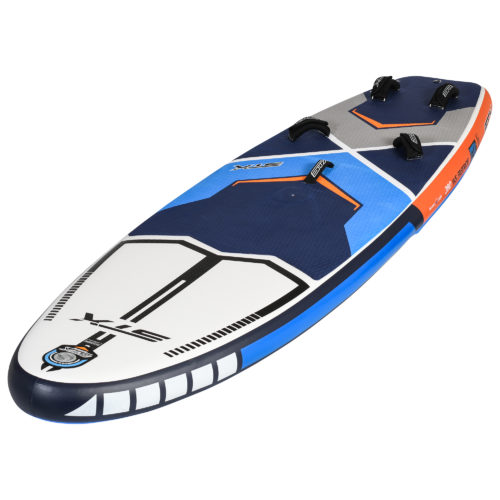
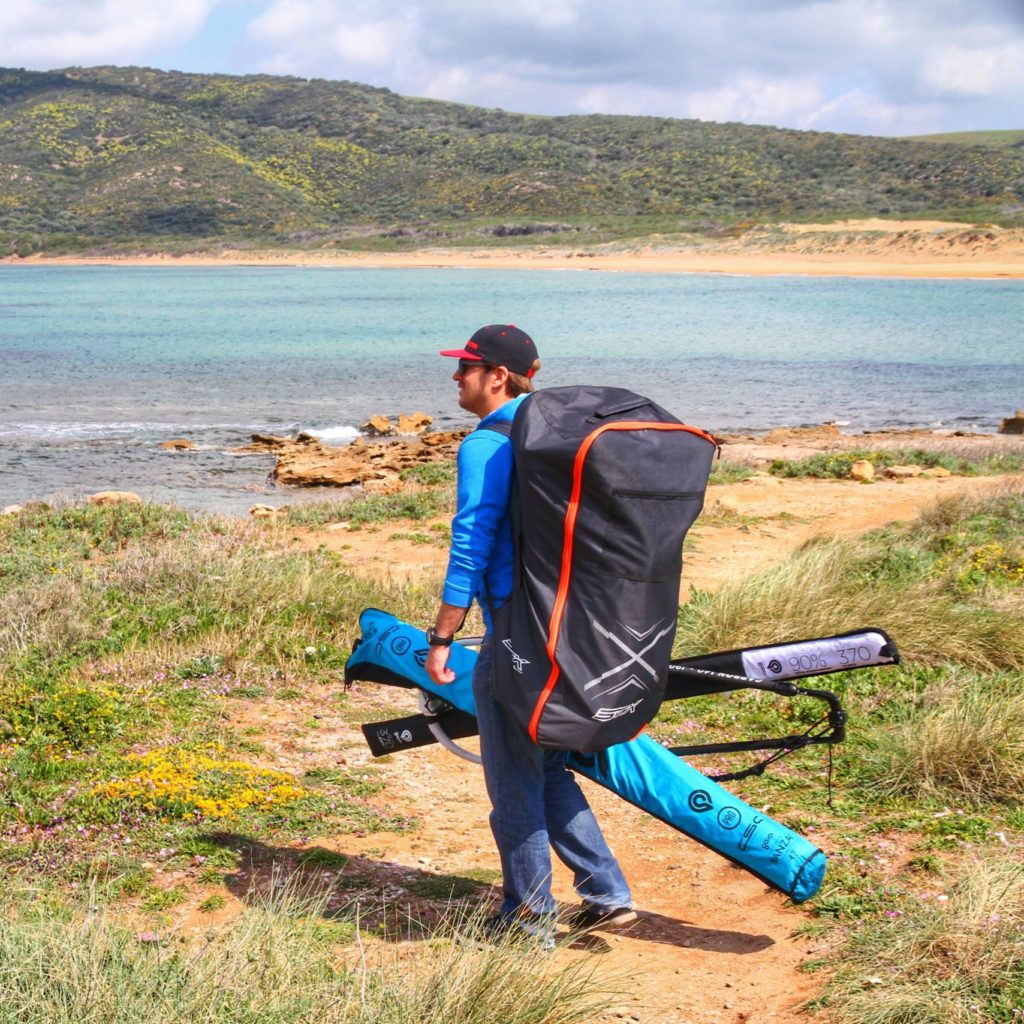
The STX features two fin boxes in the rear of the board and one centre fin in the middle. The centre fin is removable for planning conditions in the hands of more advanced riders. All three fin boxes protrude from the base of the board which does increase drag and there is a little flex in the rear fins when loaded laterally at higher speeds. The rear fin boxes are US slot boxes with a screw fin system and the centre box uses a slide in fin with a clip similar to what is found on the other STX Stand Up Paddle Boards.
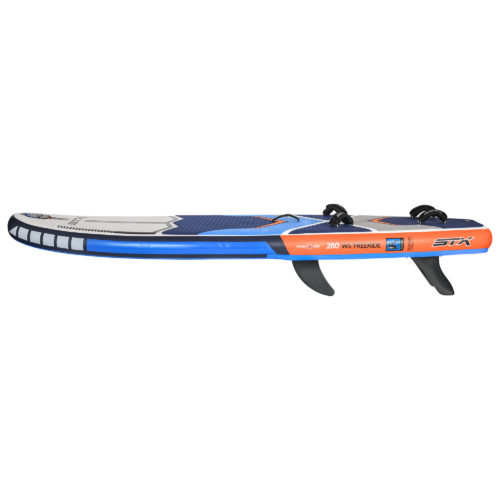
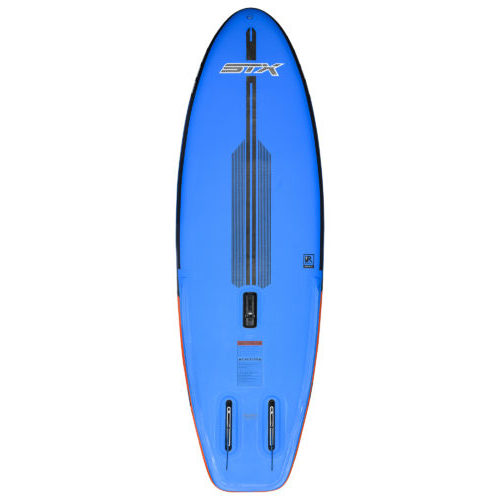
The mast base is a single threaded hole in the board and STX recommend that you use a “cardan” (hinged) mastfoot with this board to reduce loads which could potentially pull the mast base out of the board. The mast foot thread is covered with a sticker saying “recreational use only” when you first unpack the board.
Unpacking
The STX 280 Windsurf comes in the same bag as all STX inflatable SUPs. In the bag there is the same high quality pump supplied with all STX boards (The deflate function comes in handy with this model), three fins and the repair kit. The 280 Windsurf does not come with a paddle.
When first unrolling the board it is worthwhile remembering how it was folded up and packed in the bag as with the extra fin box it is not necessarily obvious how to best fold the board to pack it away at the end of the session.
With the supplied pump the STX Windsurf board pumps in under 10 minutes. The board feels quite hard and stiff for an inflatable board when on the water with 15 psi of pressure. The valve on the board states that it can take up to 20 psi, but I am not aware of how this might affect your warranty.
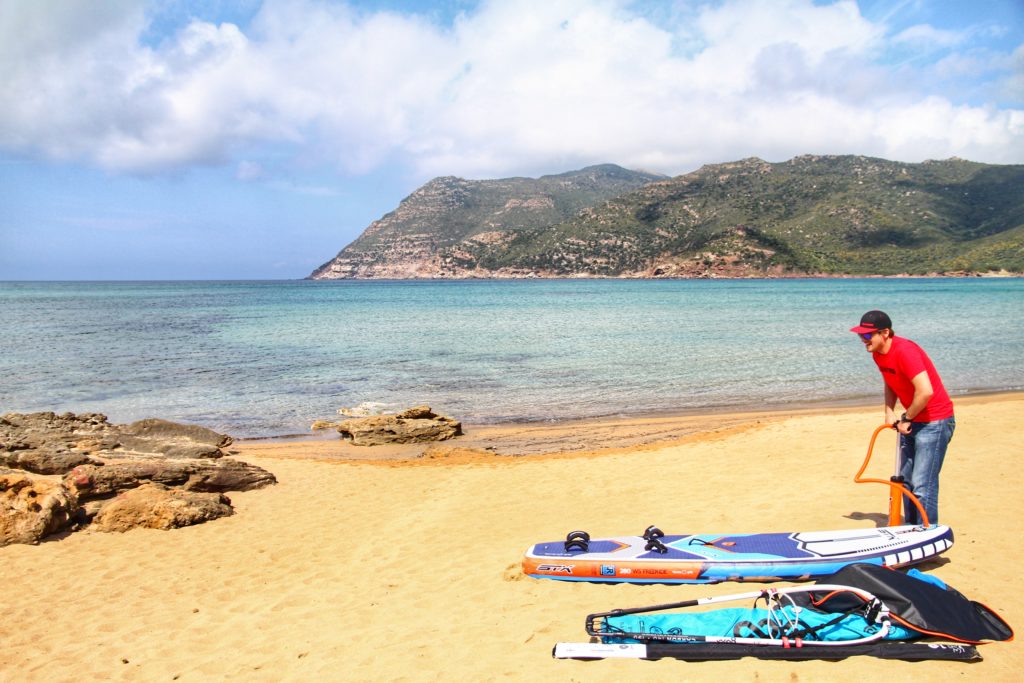
On the Water
Advanced Sailor
For a more advanced sailor the board definitely feels different to a hard board. But it would be unfair to compare a 899CHF inflatable windsurf board to a 2000CHF+ Carbon board. At 80kg I could feel a very slight give in the deck which felt similar to how a slightly delaminated hard board might feel.
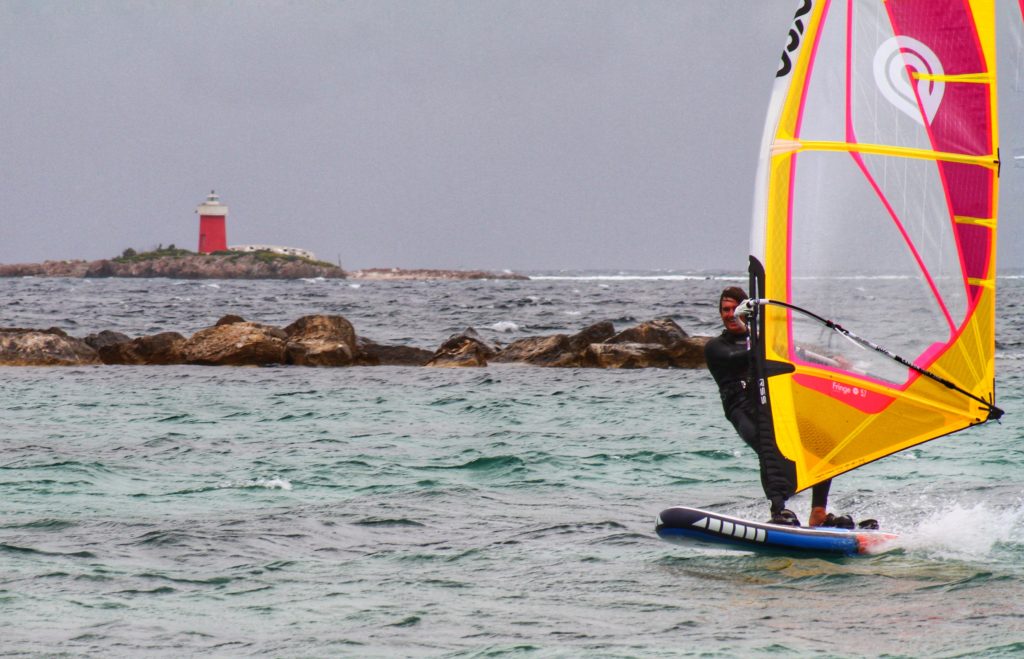
The volume is immediately evident and if you are used to sailing smaller boards it does take a moment to get used to this. But, bearing away in about 18 knots of wind the board started to rise onto the plane as you would expect with just a little extra drag compared to a hard board. Once planing you do feel a little drag from the external fin boxes but the board does release to give a proper sensation of windsurfing. I managed to get almost 20 knots out of the board which was not much slower than the speed I was going on my wave board in the same conditions.
The volume makes the board very stable off the plane and normal low speed maneuvers like tacking and gybing are very easy on this board. Due to the good quality deckpad which provides considerable grip the board is ideal for practicing any manouvers you might want to learn in lighter winds. Once planing foot steering works, but the board is quite challenging to plane through a gybe preferring a flarve technique of foot steering in and flaring the board out.
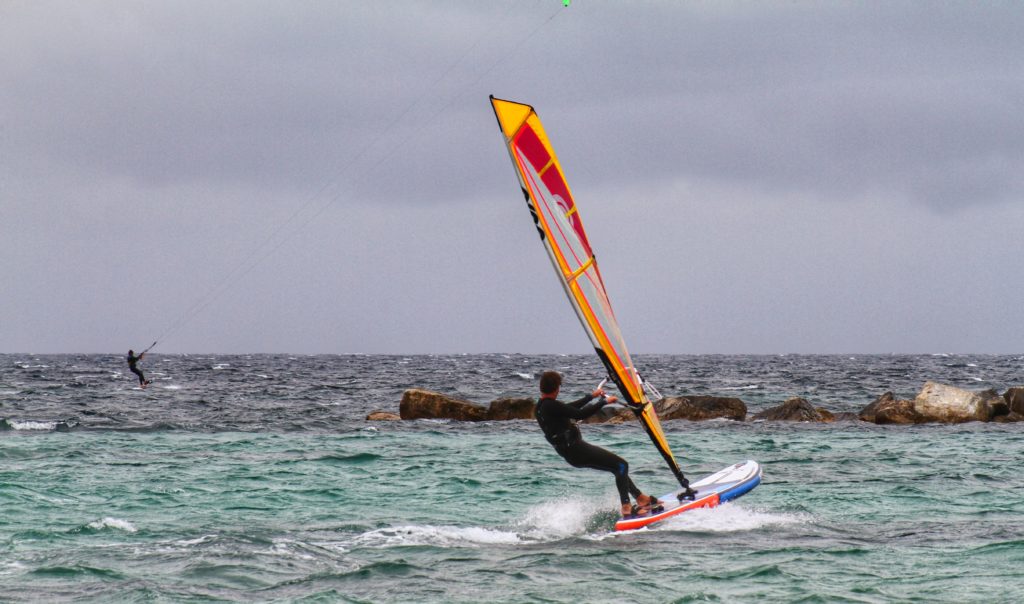
Beginners
The high volume of the STX along with the soft edges and good deck pad lend it to being an ideal beginner/intermediate board. I’ve thought beginners up to 100kg on the STX over the summer of 2019 and it has proven to be a very dependable board for those taking their first steps.
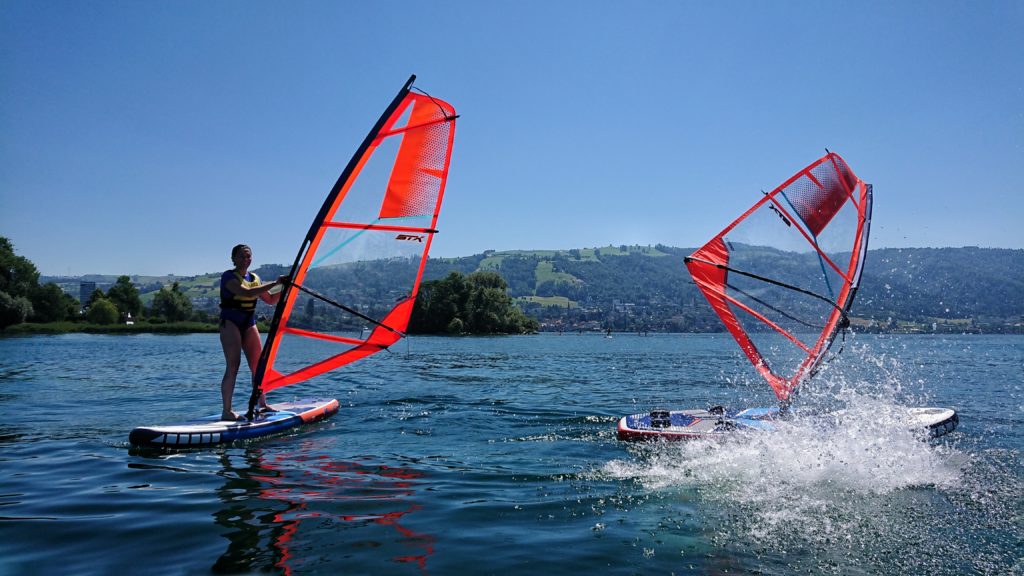
The relatively short length and centre fin make the board very maneuverable and with flat water conditions most beginners can learn and progress quickly. The stable platform allows total beginners to concentrate on learning how to handle the sail and progressing sailors can use this stability to think about their technique rather than just trying to stay on the board.
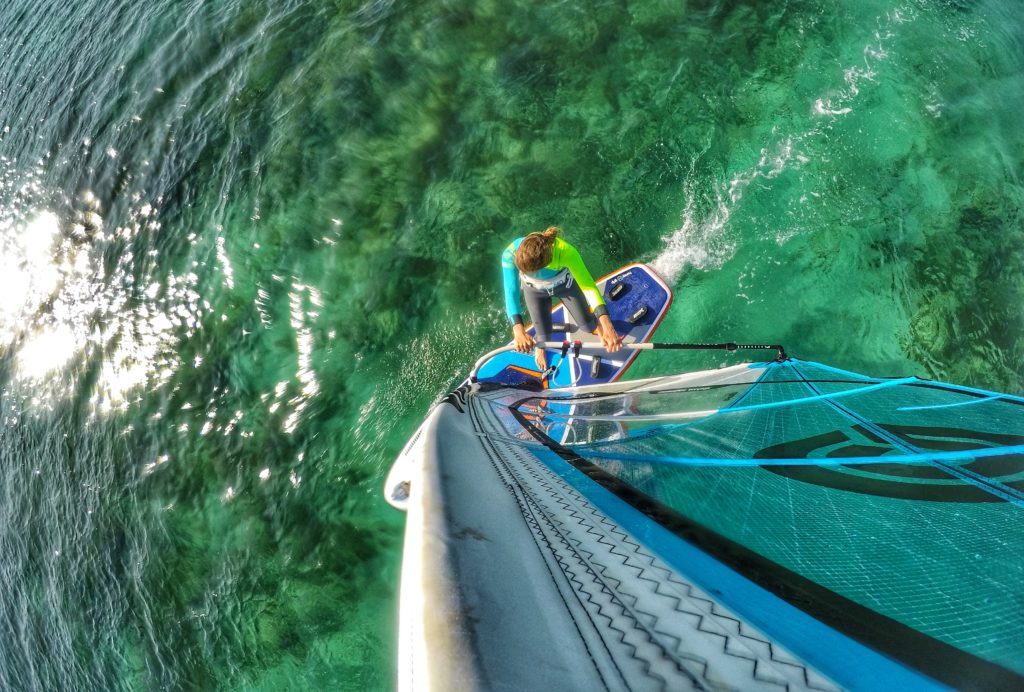
I would go as far as to say that this is possibly one of the boards that I have had most success with in teaching beginner and intermediate windsurfers.
SUP
While developed primarily as a Windsurf board, the 280 Windsurf also works quite well as a Stand Up Paddle board. At 9’2″ the board is shorter than most other inflatables, but offers great stability and maneuverability at the cost of a very slight reduction in gliding ability. When paddling with someone else on a 10’6″ inflatable I did not really feel disadvantaged, but the board did feel like it needed just a tiny bit more energy over a standard SUP. The only thing missing (in my opinion) for using the 280 Windsurf as a SUP board would be some bungee cord on the nose to allow carrying a drybag along when going for a paddle.
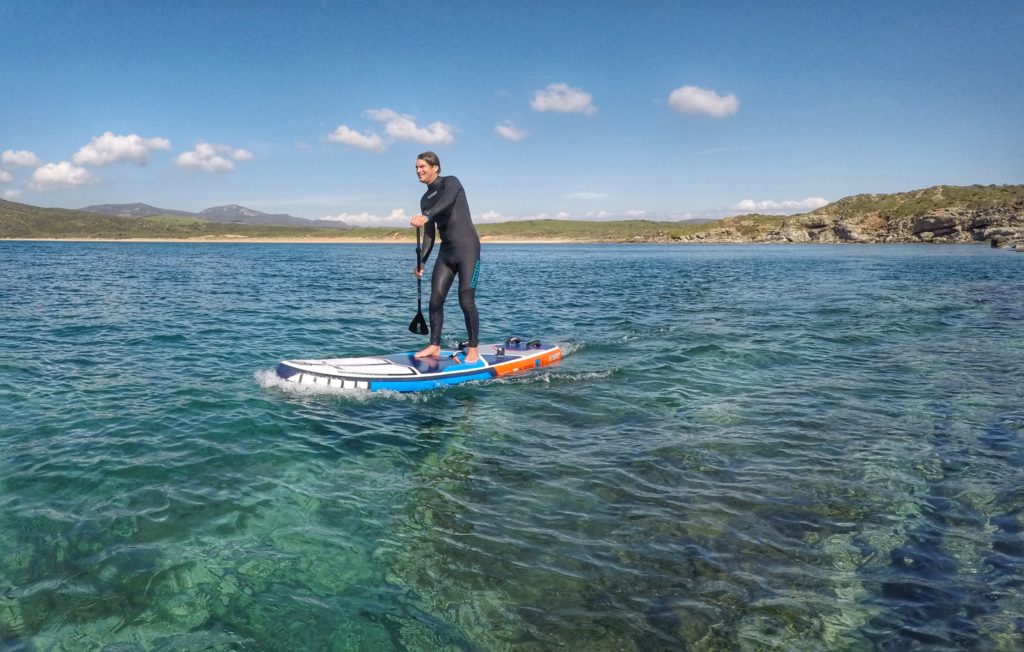
Some taller or heavier people I’ve had out to try out a range of SUPs actually choose the STX Windsurf board as their SUP of choice, due to it’s stability. So, the STX 280 Windsurf can definitely also be used as a SUP board if you are so inclined (paddle sold separately)
Packing Up
Packing was probably the most challenging element of using the STX 280 Windsurf, but with a little practice this can also be mastered. Due to the box for the centre fin the board can not be simply rolled up like other iSUPs. The board first needs to be folded from the nose to about half way along it’s length, then the tail needs to be folded over the back of the fin boxes and the board folded from the tail to meet the section which has been folded from the nose. Using this method ensures that the board can fit easily in the bag despite the extra fin box. Using the deflate function on the supplied pump to remove all the air from the board definitely makes folding the board easier.
Pros
- Price
- Ease of Use
- Stability
- Versatility
- A toy for the whole family
- Lighter than a hard board of similar volume
Cons
- A little cumbersome to pack up at first
Summary
The STX 280 Windsurf is a great value for money board for a family who would like one board to do it all for Stand Up Paddle or Windsurfing. The ability to store the board in it’s backpack greatly helps with storage and transport. For those who already windsurf at a higher level the board is a great toy for lighter winds in the summer or to teach your family and friends to the sport. If like me you are generally sailing in higher winds on small wave boards the STX can be a great compliment and allow you to get out and play in the summer on days when you would otherwise sit on the beach.
Availability
The board is available in Switzerland through Swiss Alpine Adventure/Wannabe Watersports. Use the contact link above or on Swiss Alpine Adventure to contact us for more info.
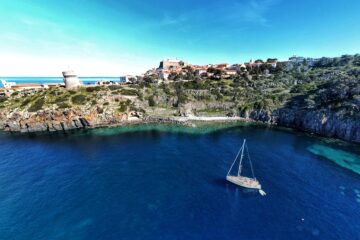
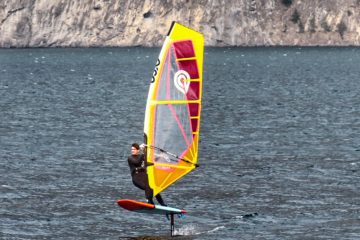
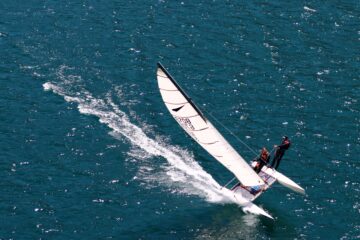
17 Comments
Dave · 24/02/2020 at 10:37 am
Review was spot on .Bought one in May 2019 in UK.Took it to France to go on the lakes.Flew back to Australia with it.Will take it back with me this year if coronovirus doesn’t stop me.Packed in a bag I bought it weighed about 17kg perfect for flying.
Dave · 24/02/2020 at 10:37 am
Review was spot on .Bought one in May 2019 in UK.Took it to France to go on the lakes.Flew back to Australia with it.Will take it back with me this year if coronovirus doesn’t stop me.Packed in a bag I bought it weighed about 17kg perfect for flying.
Per · 19/08/2020 at 5:13 pm
Have you tried it in rivers and whitwater?
Are the footloops removable?
No D-rings at all for packing?
wannabewindsurfer · 31/08/2020 at 9:44 am
I’ve not tried it in white water. The foot straps are removable but there are no D-Rings or bungee cords for stowing anything on the board. There is a leash D-Ring and a towing D-Ring.
MichaelS · 20/07/2021 at 4:25 pm
I just bought one and am pleasantly surprised with the quality of the board and fittings. This will go to Brazil with me in October. Although there are no D-rings or Bungee cords these are easily purchased.on Amazon Germany etc. and then applied on the front with either the glue in the repair kit or with 2-sided 3M tape which I have used in the past to apply a skeg to an inflatable kayak. Holds fine. The bungee cord can easily be removed if it gets in the way.
NicoB · 10/01/2022 at 10:13 am
Excellent review. Great board to learn to windsurf, improve tricks, and plaining. Had also great fun with it in low wind conditions and small waves. Packing was no problem for me, but I would prefer only a center foot strap at the end of the board instead of two.
Leon Steyns · 01/07/2022 at 11:09 pm
Thanks for the great review!
I see that you use a Goya 5.7m sail, but the STX sails in the learner’s photo seem much smaller.
What size(s) sails do you recommend?
wannabewindsurfer · 01/07/2022 at 11:37 pm
For teaching beginners, I use anything from 3.2 to 4.4 sails which work very well with these boards for giving the first steps on the water. If I sail the board in planing conditions myself I usually use the 6.5 STX HD2 rig or one of my Goya wave sails. I would suggest that any sail up to a max of about 6.5 will work with the boards, but I’d not use it in planning winds where I would be on smaller than probably a 5.5, but for beginner/intermediates, you could use any sail up to 6.5.
Leon Steyns · 05/07/2022 at 12:12 am
Thank you!
Jerome · 13/09/2022 at 12:46 pm
Hi !
Very informative review indeed ! Thank you very much !
I considered buying a “JP Australia – Magic Air (250) / Funstair (280)” at first, but the cost is a bit too high IMHO…
I’m quite suprised by the similarity between the 2 STX models (250 & 280) and the 2 JP models… But more than 2 times cheaper for the STX ones !!! So maybe It will be my choice…
I’m still hesitating between the 280 and the 250 STX.
Do you have an opinion on wich is the more suitable for a more experienced windsurfer / stronger winds / performance ?
Thank you !
wannabewindsurfer · 13/09/2022 at 1:01 pm
Hi Jerome,
The 250 is better for an experienced windsurfer. There is not a huge difference, but the 250 has a rounder plan shape and is shorter. The rounder plan shape makes it a little bit more gybable… although you won’t do a proper carve gybe om any of these boards. With the 250 you can gently foot-steer in and then flare the board to finish the gybe. I usually use the 250 myself (when I did the original test the 250 didn’t exist) and use the 280s for teaching beginners.
Hope this helps.
Jerome · 13/09/2022 at 1:17 pm
Wooo !!! That’s what I call a fast and useful answer !!! Thank you very much !!!
The 250 was my first choice, but even more now with your feedback !
Cheers !
Jerome (I’m from France, so sorry for my bad English !)
Jerome · 14/09/2022 at 9:33 pm
I just saw that STX is one of your “partner”, so maybe you have a kind of “biased” point of view ? (sarcastic mode off).
Nevertheless, what do you think of the STX HD2 rig, compared to other “premium” sails/masts ?
I now ordered the STX 250 board, and I wonder if I’ll give a go with the HD2 rig or opt for a more efficient sail/mast combo (maybe second hand though).
Don’t you find the HD2 has a “too flat” profile, compared to other sails (cambers let alone) ??
Thank you !
wannabewindsurfer · 14/09/2022 at 9:58 pm
Hi Jerome,
I use the boards for teaching and also occasionally go for a blast on them myself. I pay for the boards and went after them myself as the fitted the concept of what I want to do which was have a mobile setup which I could use to try and get more people into windsurfing. I’ve thought peopel from complete beginners to getting in the footstraps on the STX equipment. They suit my needs well as I don’t have space to store hard boards and I can have a mobile setup with these boards to get them to the beach/lake.
The boards or the sails cannot be considered “high performance”, which I think I say in my review, but they do work. I think of them in terms of value for money. The STX250 with the HD2 6.5 rig is definitely on the lower end of recreational in terms of performance, but having said that I’ve gotten that kit up to 19 knots board speed, which I don’t think is bad for an inflatable board. You feel more drag when doing fully planing than on a hard board, but it’s also a fraction of the cost of a hardboard.
The HD2 Rig is heavy if you are used to using high-performance rigs. It’s a considerable difference between the 6.0 HD2 and my 6.0 Goya Banzai, but the mast alone for my Banzai rig costs more than the entire HD2 rig. It all comes down to what you are looking for. The STX boards and HD2 rig are a good low price entry to windsurfing, easy to store, easy to transport and they it is possible to get them planing and sail them in stronger wind, but you can also take them out on a summers day in light wind and just play around on the water. They are very stable platforms for practicing things like helicopter tacks, but the swing weight of the HD2 rig is relatively heavy.
I would not compare the HD2 rig to a camber-induced rig in any way. They are completely different concepts. The rig is an entry-level recreational setup. It does get a bit backhanded when overpowered but you can sheet in and keep it centered if you drive it. I’ve sailed the 6.5 on the 250 board in over 20 knots of wind and I wouldn’t say I was fighting with the rig, but I could definitely feel my backhand. When sailing like this you notice that the board also has no rocker as you drive it flat when sheeting in. If you are looking for performance then you might consider a second-hand wave or freeride sail, but if you want a cheap new sail which works (but is a little on the heavy side) then the STX is worth considering.
Hope this helps
Regards,
Dave
Jerome · 15/09/2022 at 9:53 am
Thank you for the comprehensive answer, much appreciated !
I’m still puzzled though… If I find a good second hand NeilPryde or GA and carbon mast, I’ll probably go for it, otherwise I’ll give a go withe HD2 rig…
Cheers,
Jerome
Olivier · 27/07/2023 at 10:03 pm
I saw that Stx released a 242 iwindsurf .
Any info about it ?
I would like to use it site a 7m2 and 5m2 Sails around the world.
wannabewindsurfer · 01/08/2023 at 4:16 pm
I’ve sailed the 242 with a 7.0m2 STX sail. I’ve not really gotten planing on it properly yet, but my feeling is that it is best suited to lighter riders and children as a learning or playing around board. The board still has huge amounts of volume, but the length is not really there to get it moving forward in sub-planing conditions and it’s just not quite stiff enough to plane any earlier with a 7m sail as opposed to a 6.5m. I will be testing it again soon though and will hopefully have some more solid feedback then.